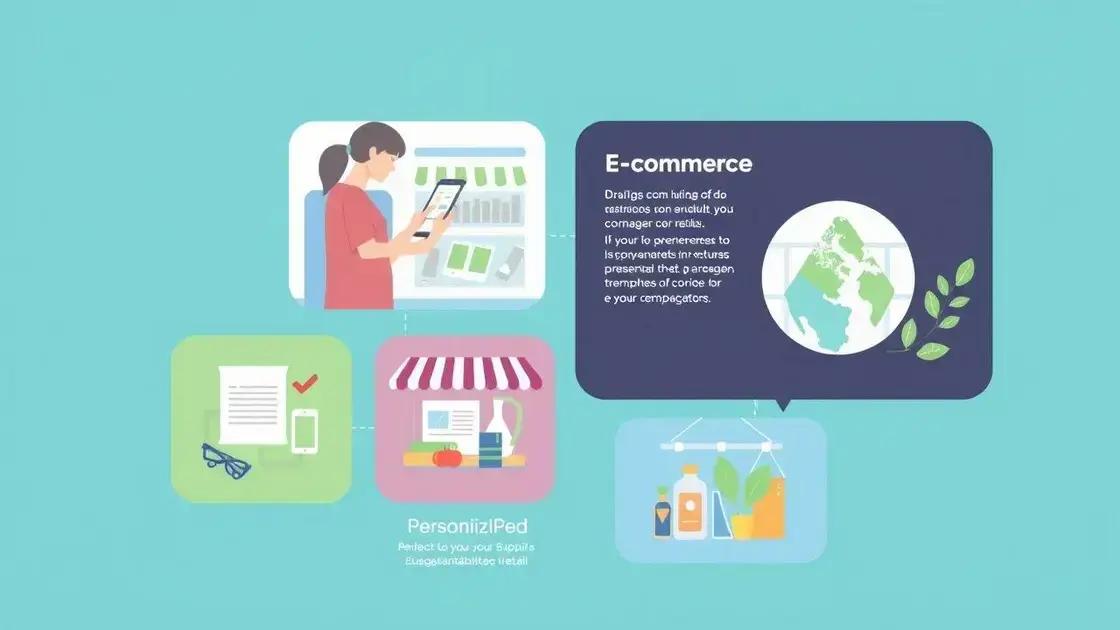E-commerce growth patterns trends shaping the future

E-commerce growth patterns trends reveal that online sales are increasing, driven by technology, personalization, and sustainability, highlighting the need for businesses to adapt to changing consumer behaviors.
E-commerce growth patterns trends are continually evolving, affecting how businesses engage with customers online. Have you ever wondered what drives these shifts? In this article, we’ll dive into the latest trends that are shaping the e-commerce landscape.
Understanding current e-commerce growth patterns
Understanding the current e-commerce growth patterns is crucial for businesses aiming to thrive online. As more consumers shift towards digital shopping, recognizing these trends can help companies adapt and succeed.
Market Expansion
The e-commerce market is expanding rapidly. This growth is fueled by several factors that influence buying behavior and online shopping experiences. For instance, the rise of mobile shopping has made it easier for consumers to purchase goods directly from their smartphones.
Key Drivers of Growth
- Increased internet accessibility
- Improved delivery services
- Personalized shopping experiences
- Innovative payment solutions
These drivers have transformed how we shop. Customers now expect faster service and a more personalized approach, prompting businesses to enhance their online presence.
Moreover, social media plays a vital role in driving traffic to e-commerce platforms. Consumers frequently discover products through social channels, prompting retailers to utilize these platforms to boost visibility and direct sales. This is a game-changer for marketing strategies, as companies need to invest in social media to capture audiences effectively.
Emerging Technologies
The adoption of technologies like artificial intelligence and augmented reality is also shaping e-commerce growth. These advancements allow customers to interact with products virtually, enhancing their shopping experience. Companies that integrate these technologies are likely to see higher engagement and conversion rates.
Additionally, analyzing consumer data helps businesses tailor their offerings to meet specific needs. Understanding preferences and trends enables brands to innovate and remain competitive in this ever-changing landscape.
As the e-commerce world continues to grow, staying informed about these patterns will allow businesses to navigate challenges and leverage opportunities in the market.
Key trends influencing e-commerce success

Key trends influencing e-commerce success are transforming the online shopping landscape. Understanding these trends can help businesses stay competitive and meet customer expectations.
Omnichannel Retailing
The rise of omnichannel strategies allows customers to shop seamlessly across various platforms. This means that consumers expect their experiences to be consistent whether they are shopping online, via mobile, or in-store. As a result, businesses need to ensure that they provide a fluid transition between these channels.
Personalization
Another significant trend is the demand for personalized shopping experiences. By leveraging data analytics, businesses can tailor suggestions and offerings to individual customers. This approach not only boosts customer satisfaction but also increases conversion rates.
- Custom recommendations based on browsing history
- Targeted email marketing campaigns
- Dynamic website content for returning visitors
Moreover, artificial intelligence plays a crucial role in enhancing personalization. By understanding customer behavior, AI can aid retailers in presenting the right products at the right time, creating a more engaging shopping journey.
Sustainability
Today’s consumers are increasingly concerned about sustainability. Businesses that adopt eco-friendly practices not only attract socially conscious shoppers but also build loyalty. Practices like using sustainable materials, reducing waste, and offering eco-friendly delivery options resonate well with modern consumers.
In addition, transparency regarding sourcing and production processes is vital. Companies that openly share their sustainability efforts can earn consumer trust, leading to improved sales and reputation.
As e-commerce continues to evolve, remaining aware of these key trends will help businesses craft strategies that lead to long-term success in the online marketplace.
The role of technology in shaping e-commerce
The role of technology in shaping e-commerce is significant and continually evolving. New tools and innovations are enhancing the shopping experience and changing how businesses operate online.
Automation and Efficiency
Automation is one of the most impactful technological trends in e-commerce. By automating processes such as inventory management, order processing, and customer service, businesses can improve efficiency and reduce human error. This enables companies to focus more on strategy and growth rather than routine tasks.
Data Analytics
Data analytics tools provide essential insights into customer behavior and preferences. By analyzing purchase history and browsing patterns, businesses can identify trends and tailor their offerings effectively.
- Predictive analytics for inventory stocking
- Customer segmentation for targeted marketing
- Real-time sales tracking
This data-driven approach allows for informed decision-making, ultimately enhancing customer satisfaction and loyalty.
Mobile Commerce
With the rise of smartphones, mobile commerce has become increasingly vital. Technology enables users to shop anywhere and anytime, making it essential for e-commerce businesses to develop mobile-friendly websites and applications.
Responsive design and simple navigation are crucial to cater to mobile users. As a result, companies that invest in mobile technology often see increased sales and customer engagement.
Artificial Intelligence
Another influential technology is artificial intelligence (AI). AI enhances customer service through chatbots and personalized shopping experiences. These tools can answer questions in real time and provide tailored recommendations, leading to improved user engagement.
As technology continues to advance, businesses must embrace these changes to stay competitive. Understanding and integrating technology into e-commerce strategies will allow companies to thrive in a dynamic marketplace.
Future predictions for e-commerce growth

Future predictions for e-commerce growth suggest exciting developments on the horizon. As technology and consumer behavior shift, businesses need to adapt to thrive in the competitive landscape.
Increased Online Sales
Experts predict that online sales will continue to soar. With more consumers shopping online, e-commerce platforms must enhance their user experience. This growth is driven by convenience, growing internet access, and mobile technology. Ultimately, businesses that embrace these changes will flourish.
Emerging Markets
Emerging markets are becoming increasingly important in the e-commerce sector. Countries like India, Brazil, and parts of Africa show rapid digital adoption. Businesses venturing into these regions can tap into a huge consumer base.
- Investing in local payment methods
- Understanding cultural preferences
- Optimizing local logistics for delivery
As these markets expand, the potential for significant growth is immense.
Technological Innovations
Technological innovations will play a vital role in the future of e-commerce. Advancements in AI and machine learning will allow businesses to offer more personalized shopping experiences. Additionally, technologies like virtual reality (VR) will enable customers to engage with products in exciting ways.
Automation will streamline operations, making processes more efficient and reducing costs for e-commerce businesses. As companies integrate advanced technology, customer satisfaction is likely to improve, driving sales further.
Focus on Sustainability
Consumers are increasingly prioritizing sustainability. E-commerce businesses that adopt eco-friendly practices are set to gain a competitive edge. This includes using sustainable packaging and offering carbon-neutral shipping options.
Brands that actively communicate their sustainability efforts will likely attract environmentally-conscious shoppers. Creating a positive impact while running a successful business will become a key focus.
As we look to the future, staying informed about these predictions will help businesses prepare for the dynamic shifts in the e-commerce landscape.
In conclusion, understanding the growth patterns and trends in e-commerce is essential for businesses aiming to thrive in the digital landscape. With increasing online sales and evolving technologies, companies must adapt to meet consumer expectations. Moreover, sustainability and personalization will play pivotal roles in shaping future strategies. By embracing these trends, businesses can position themselves for success in an ever-changing market.
FAQ – Frequently Asked Questions about E-commerce Growth Trends
What are the current trends in e-commerce growth?
Key trends include increased online sales, mobile commerce expansion, and a focus on sustainability in business practices.
How is technology impacting e-commerce success?
Technology, including AI and automation, is enhancing customer experiences, improving efficiency, and enabling personalized shopping.
Why is sustainability important in e-commerce?
Sustainability is becoming a priority for consumers, and businesses that adopt eco-friendly practices can attract more customers and build loyalty.
What should businesses expect for the future of e-commerce?
Businesses should prepare for continued growth in online sales, greater technological innovation, and an emphasis on personalized customer experiences.





